DIY well rings: step-by-step technology for making reinforced concrete rings
For the construction of well shafts, only natural materials were once used: stones and logs.With the advent of reinforced concrete products, the technology for constructing autonomous water supply facilities has become much simpler.
Nowadays, to strengthen the walls of the mine, reinforced concrete rings for wells are used, which are produced in factories. However, you can make such elements yourself - the technology is quite simple and does not require special skills or expensive materials.
We will tell you what size of rings is best to choose for a well, describe the method of making a concrete mixture and methods for constructing split molds for pouring the structure. We supplemented the step-by-step technology with visual photo instructions, diagrams and videos.
The content of the article:
Typical sizes of reinforced concrete rings
If for some reason you cannot use ready-made products, then the owner of a country or summer cottage should think about options for making them yourself.
To do this, you need to make a mold from available materials, install a reinforcing mesh into it, and then pour in a concrete solution mixed in strictly defined proportions.
At factories producing reinforced concrete products and designs, special product labeling is used. Typical sizes of well rings:
- height standard and is 900 mm;
- thickness — 70-140 mm;
- diameter — 100-200 mm.
The thickness of the cylinder wall and its diameter may vary.
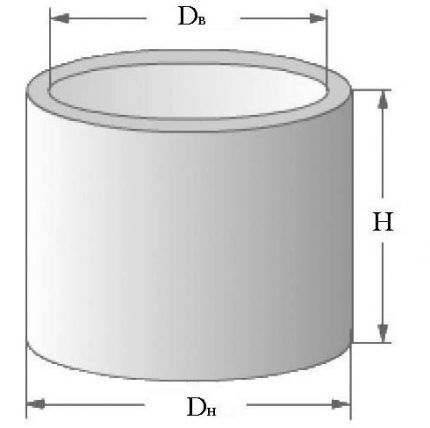
With an increase in the diameter of the ring and the thickness of its walls, the consumption of concrete increases. The weight of the product also depends on these dimensions. To reduce the mass of the finished product, they try to reduce only the height of the reinforced concrete ring, and make the walls as thick as possible.
On sale you can see products with a height of 350, 450 or 500 mm. They are also called additional rings and are installed upon completion of work, when a product of standard sizes no longer fits entirely into the dug well.
Another way to “legally” reduce the weight of a well ring is through the mandatory use of reinforcing mesh. In this case, the wall thickness can be 6-8 cm, which does not impair the strength characteristics of the product. Therefore, it is better to make reinforced concrete rings with your own hands for building a well on the site.
It is necessary to reduce the weight of the well ring in order to avoid the use of lifting equipment during installation work. This is important for summer residents and gardeners who decide not only to make products with their own hands, but also to move them around the site without the use of special equipment.
Homemade rings are a practical and affordable solution not only for well arrangement, but also to solve other problems. For example: creating a drainage well or drain hole.
Mixing concrete mixture
To prepare concrete that will later be used to make rings, you will need:
- cement (knitting material);
- sand (fine aggregate);
- crushed stone (large aggregate);
- water.
To obtain high-quality concrete, buy grade 400 cement, packed in 25 kg paper bags. If you do not intend to use the building material right away, then take care of its proper storage.
The bags are stored in a dry place. It’s even better to pour the cement into closed iron containers. If possible, use purchased cement immediately after purchase.
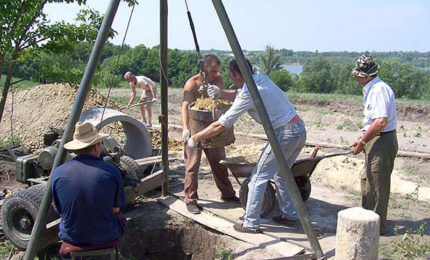
To mix concrete, stock up on quartz sand, which is considered an ideal fine filler. Silt, clay and other types of impurities contained in the delivered bulk material will negatively affect the quality of the concrete mixture. Therefore, such sand is washed with water, ridding it of unnecessary impurities.
Not all crushed stone is suitable for mixing concrete used for casting rings. Choose granite crushed stone with grains that have a cubic shape, which promotes better adhesion of the material with other ingredients of the concrete mixture.
You should not use lamellar (needle-shaped) crushed stone.Crushed stone contaminated with clay is also washed with water before mixing.
To cast reinforced concrete rings, granite crushed stone with a fraction size not exceeding a quarter of the thickness of the product is purchased. For a ring with a 10-centimeter wall, crushed stone is suitable, the grain size of which will not exceed 20 mm.
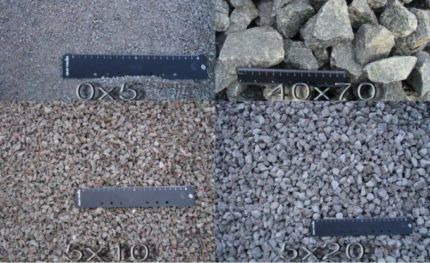
The ratio of ingredients in concrete mortar
The properties of a concrete solution directly depend on the number of components included in its composition, as well as on their volume and mass. When drawing up the relationship between the three main ingredients necessary to obtain high-quality concrete, it is assumed that the amount of cement is equal to one.
To cast well rings, mix the concrete mixture using cement, sand and gravel in a proportional ratio by volume of 1:2:3 or by weight of 1:2.5:4.
For example, a bucket of cement, two buckets of sand and three buckets of gravel are poured into a container. Add half a bucket of water. Or take 100 kg of cement (4 bags), add 250 kg of sand and 400 kg of crushed stone. Add 50 liters of water.
To prepare one cubic meter of concrete it takes 300 kg of M-400 cement, 750 kg of sand and 1200 kg of crushed stone. The mixture is diluted with 150 liters of water.
How is the amount of water calculated?
Water affects the mobility of the concrete mixture and the strength of the products after it hardens. The ratio of water and cement in the solution is called the water-cement ratio and is designated W/C.
For reinforced concrete rings, this value should be no more than 0.5-0.7. In the examples discussed above, W/C was 0.5. In this case, the mass or volume of the taken cement is divided in half and the required volume of water is obtained.
A more liquid solution is easier to pour into molds and compact, but it will have to be kept in the workpiece longer. The time for the initial hardening of the solution increases.
The mixture, which does not spread after squeezing it into a lump with the palm, allows you to immediately remove the workpiece and use it for stamping the next product. True, it is more convenient to compact it with the help of vibrators.
Methods for mixing concrete mortar
The manual method of mixing the components of a concrete mixture is now rarely used. Factory-made and home-made concrete mixers cope better with this labor-intensive task.
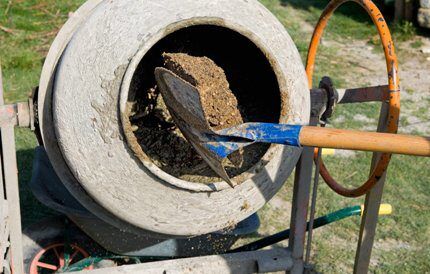
Sand and cement are poured into a concrete mixer, then water is added, and then crushed stone, previously moistened with water. Having received a homogeneous mass, the equipment is turned off and the solution is poured into a container on wheels. This allows you to transport heavy concrete to the place where the ring is poured.
Production of split molds
Before you start making rings for building a well with your own hands, you must first make a metal split mold for pouring concrete or wooden formwork from its component parts. Both are made from scrap materials available on the site or borrowed from friends.
Many companies offer ready-made molds for making reinforced concrete rings. It is not profitable to purchase them for one time; it is better to rent them. You can see how they are constructed and borrow some elements to build your own mold.
How to make a metal mold?
A homemade collapsible mold, consisting of two rings of different diameters, is made from metal barrels, pipes, air ducts and other metal structures suitable for this purpose.
Two cylinders are inserted into one another so that there is an equal distance between them, equal to the thickness of the well ring. So that the outer and inner parts of the form can be easily removed after the concrete has set, you need to cut them into two parts with a grinder.
It is more convenient to remove the inner cylinder if it consists of three separate parts. Although you can handle two, you just have to tinker around inside the ring longer.
All components of the form must have fastening elements that do not allow the form to move apart while filling the interannual space with concrete.
The following are used as fasteners:
- door or window awnings;
- welded lugs, tightened with a bolted connection;
- other devices that can cope with the task.
It is advisable to weld handles onto the walls of the cylinders to make it easier to tear the mold off the concrete. To make the process of shooting the mold as easy as possible, the surfaces of the cylinders in contact with the concrete should be lined with plastic film. You can lubricate them with used engine oil, but this is not welcomed by environmentalists.
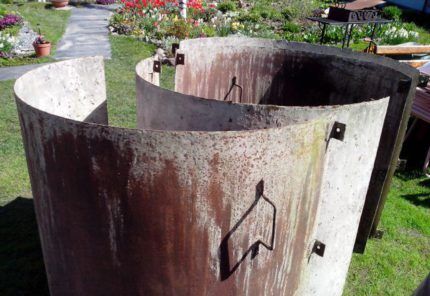
To maintain equal distances between the cylinders, wooden or metal spacers are used to reliably fix the position of the two ring-shaped parts of the mold.
It is important to ensure that the outer blank of the formwork for reinforced concrete rings easily opens outward, and the inner one also moves freely in the opposite direction.
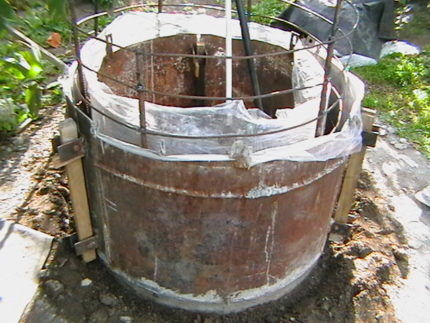
How to assemble wooden formwork?
It is not difficult for a good carpenter to make formwork for casting concrete rings from scrap lumber. Two cylindrical surfaces are made from wooden rings, to one side of which boards are nailed.Their thickness must be at least 20 mm, but not more than 40 mm.
The boards are well planed on both sides, making the surface as smooth as possible. For ease of disassembly, the wooden cylinder is cut into four parts. To fasten adjacent workpieces, wooden planks, bolts, hooks, steel staples and other devices are used.
The inner wall of the wooden formwork, which has a smaller diameter, is assembled in a similar way. Only two wooden rings of smaller diameter and the same board (20-40 mm) for cladding are taken as a basis. If in the first case the boards are nailed along the inner circle, then in the second - along the outer one.
The result is two attached cylinders, forming a space between their surfaces, which is subsequently filled with concrete. The smaller cylinder is sawn into three parts. If you cut it in half, you need to provide a small gap (1.5-2 cm) to make it easier to remove the internal formwork.

Method of making wooden rings
Wooden rings for formwork are cut from a square panel made of 20 mm boards laid in two layers perpendicular to each other. The first layer is laid across, and the second - along.
The side of the square shield is calculated taking into account:
- internal diameter of the concrete ring (1000 mm);
- the thickness of its wall (80 mm);
- thickness of the formwork board (20 mm);
- width of the wooden formwork ring (150 mm).
In parentheses are approximate numbers that allow you to calculate the side of a square shield. So, to 1000 mm we add two times 20 mm, then two times 80 mm and two times 150 mm.As a result, we get: 1500 mm or 1.5 m.
A large ring for external formwork and a small ring for internal formwork are cut out of one panel at once. The rings are marked on the shield using a pencil and a rope replacing a compass.
The nail is driven into the point of intersection of the diagonals of the square, which is found by crossing two stretched strings connecting opposite corners of the shield.
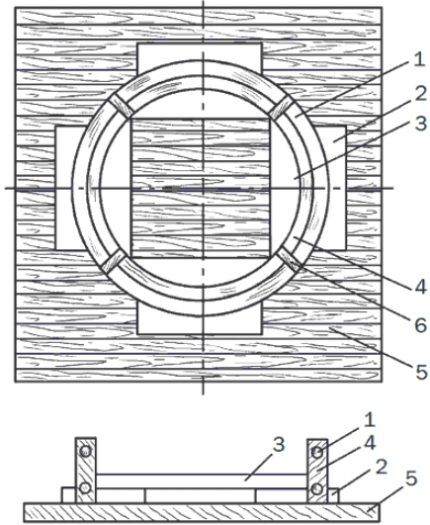
A rope is tied to the nail and, measuring the required distances, four concentric circles are drawn with a pencil. The radius of the largest circle is 750 mm, the second is 600 mm, the third is 500 mm, and the fourth is 350 mm.
Next, use a hacksaw, jigsaw or chainsaw to cut along the drawn circles, obtaining two rings of formwork. The same thing is done again, getting a second pair of rings.
All that remains is to nail the boards to the rings on the desired side, the thickness of which is 20 mm and the length is one meter (the height of the concrete ring). The boards are placed as closely as possible to each other.
After making the cylindrical walls of the outer and inner formwork, they begin to saw them into four parts. This is how a detachable wooden mold is obtained for making reinforced concrete rings at home.
Manufacturing of reinforcing frame
The use of reinforcement makes it possible to reduce the thickness of the ring, and therefore its weight. At the same time, the strength characteristics of the product and its service life increase.
For the reinforcing frame you will need:
- steel rods with a diameter of 8-10 mm (10 pieces);
- steel wire with a diameter of 8-10 mm (about 5 m);
- thin wire.
Calculate the length of the frame. To do this, recall the formula for calculating the circumference: the number Pi (equal to 3.14, rounded to 3) must be multiplied by the diameter. We take the diameter of the circle to be 104 cm so that the frame runs in the middle of the concrete ring.
We multiply this number by 3, we get 312 cm. Divide this number by 10, we get 31.2 cm. Round up to 31 cm. So, we lay out the steel rods on a flat surface at a distance of 31 cm from each other.
Next, we weld pieces of wire 315-318 cm long to them at intervals of 160 mm. We take the wire a little longer than the calculated length of the frame, so that when rolling the workpiece into a ring, you can weld its ends or twist it.
We manually bend the mounting loops from thick steel wire and weld them to the frame (you can screw them with thin wire). That's it, the frame is ready. If you don’t have a welding machine, then all the frame elements can be twisted with thin wire.
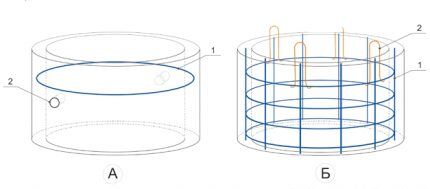
Pouring concrete mixture into a mold
When all the preparatory work is completed, they begin to manufacture the well ring.
Work order:
- Preparing the base. A sheet of iron or a wooden shield is laid on a flat surface.
- Assembling the form. The blanks are installed (one inside the other), and the parts of the formwork are carefully secured.
- Form reinforcement. A reinforcing frame is lowered between the outer and inner walls of the formwork, fixing its position with wedges.
- Pouring the structure. Thick concrete mortar (W/C = 0.5) is placed in the interannual space in small layers (about 100 mm) and compacted using a steel pin with a diameter of 20 mm. WITHthe methane solution (W/C = 0.7) is immediately poured into the mold to the brim, and then the mixture is compacted with a pin.
- Ring Alignment. After filling the entire form, they begin to level the end of the concrete ring, using a trowel to add mortar where it is missing. ANDThe product is covered with polyethylene or thick fabric.
- Removing formwork. Stripping begins after 3-4 days (if the concrete was thick), after 5-7 days (if the solution was liquid), leaving a ring on a metal sheet or wooden panel.
- Concrete maturation. The reinforced concrete ring is wrapped with packaging film so that the composition ripens evenly over 2-3 weeks, gaining final strength.
It is recommended to wet the product with water every 4-5 days while the concrete is maturing.
They do it using the same technology sump rings. Detailed information about the classification and methods of manufacturing concrete rings for sewerage can be found in this article.
Useful video on the topic
In the video clip, the master independently assembles a metal form, coats its walls with waste oil, prepares a concrete solution and fills the formwork. Using special equipment, the mixture in the mold is carefully compacted so that there are no defects in the walls of the well.
The video shows how it is easier to remove the formwork, starting from the inner ring. By the way, the well ring is made without a reinforcing frame, so the thickness of the product is at least 15 cm.
In this video, the mold is designed to cast a thinner reinforced concrete ring.The master uses steel wire as reinforcement. The story shows in more detail the process of putting ingredients into a concrete mixer.
As you can see, any healthy man can make reinforced concrete rings for a well. No special skills are required in making molds and mixing concrete mortar.
You can watch little tricks in videos on this topic. In a month, a person can cast up to ten reinforced concrete rings using one mold. This is quite enough to equip a well shaft. Its depth depends on the level of the aquifer in your area.
Do you have experience making concrete rings? Please share information with our readers, tell us about the features of your method. You can leave comments and ask questions about the topic of the article in the form below.




We did it right on the spot. The cement for the rings needs to be as dry as possible. A regular concrete mixer will not mix. I had to make it more liquid and keep it in the formwork for a couple of weeks until it hardened. We made 4 pieces in advance; with one we would have to do this for a month. For formwork, we found metal barrels of different diameters with walls 6 mm thick. Steel sheets were laid on the floor. Reinforcement frame inside. The dimensions of the rings are 106 outer diameter, 90 inner, height 90. Made without locks. They covered it with a canopy to protect it from precipitation. The formwork turned out to be durable; it was not wetted with water. There are also plastic well rings, but they do not withstand frost.
I wonder who bothers with homemade rings and how profitable it is? It takes five to ten rings to make a well, the current cost is around 1000-1500 rubles, plus delivery, we get 6000-20000. One concrete mixer from three thousand, metal formwork, as in the article, cannot be made for free, and wooden formwork will cost money. Plus a wire reinforcement frame, plus ears for lowering, plus adherence to technology. My opinion: it's not worth it.
I believe that in this case the game is not worth the candle, as they say. A colossal amount of time is wasted, plus there is a high probability of getting into a serious marriage. For your home or dacha, it’s easier to order ready-made rings and not have to worry.
We wrote above about pouring rings using iron barrels of different diameters. In this case, the idea is advisable when there is already a mold for filling the rings. Assembling from iron is very expensive, not so much from wood, but you still need some experience. Conclusion: for a particular case, such manipulations are only relevant if there is a ready-made mold for pouring rings (for example, barrels of different diameters, as in the post above. Otherwise, it is justified if done for commercial purposes.
What if you don’t remove the formwork? More precisely, to shoot, but not quite. Let's put it at the bottom of the hole and gradually pour it in and let the concrete set, move it up. Will it be a concrete pipe?
I would not recommend doing this, since it will be quite difficult to obtain a concrete pipe of durable construction in such conditions.Firstly, the joints need to be carefully reinforced, and secondly, such an idea presupposes the presence of a hole of a wider diameter for installation work. Conclusion: it’s easier to dig a regular hole, make the rings separately, then install them one by one.